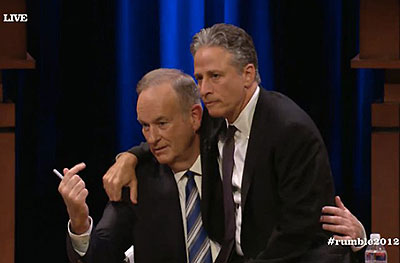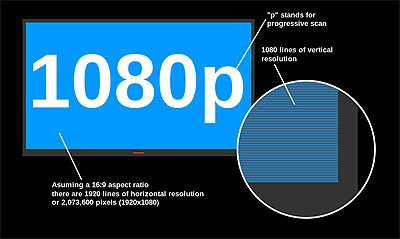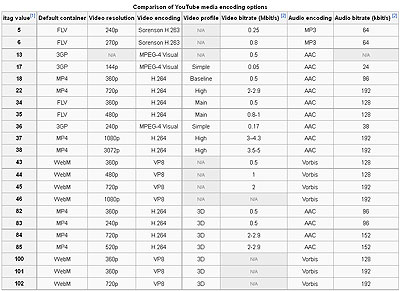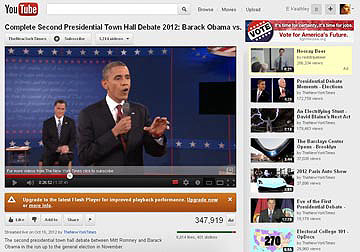TV Is Dead, Long Live TV: October 19, 2012
Published on October 19th, 2012 in: Media, Science and Technology, Streaming, The Internets, TV, TV Is Dead Long Live TV |The latest in our ongoing series on the life and death of linear television, a.k.a. old-style appointment television, TV that only moves forward in time. For previous installments, go here.

I had planned to write this week’s article on the topic of fan-produced web series, but The Rumble 2012 and the Presidential debates livestreaming are too critical to the death of linear television and the new life of Internet television to ignore. So let’s spend the next several paragraphs dissecting what has gone right, and what has gone wrong, in Internet TV over the past two weeks.
On October 6, Jon Stewart and Bill O’Reilly sold $5 virtual tickets to an audience that wanted to live stream a debate called The Rumble 2012. This should have gone well; Major League Baseball live streams games regularly, and YouTube has pulled off great livestreaming events including concerts with global audiences. Unfortunately, the streaming provider Nox Solutions suffered server crashes right before the debate. The best article so far dissecting exactly what went wrong with The Rumble 2012 was written by Kathy E. Gill over on the PBS Media Shift blog. Alex Katrowitz at Forbes also makes some decent points, comparing and contrasting the delivery of the debate with the streaming content on Louis C.K.’s website.

Illustration from Wikimedia
Gill in particular makes great points, which I won’t retread here. I will say I think the main mistake Nox Solutions made was trying to deliver the debate in 1080p. By choosing to stream the video in 1080p, Nox Solutions effectively said they cared more about making the debate look good than they cared about delivering the event in a format people could watch. It’s also just possible that the producers in charge of the event forgot that outside of television production land, people really don’t care about clear, crisp images so long as they can enjoy their favorite TV programs.
In my day job, I work with a Digital Asset Management (DAM) system that transcodes 1080p video into Windows Media Viewer (WMV) files. The WMV files look awful, but nine times out of ten that’s what users want to download rather than video at 1080p. Why do people choose to watch a tiny, blurry video rather than the great big beautiful image? Because downloading and watching a crap WMV file is faster and easier than waiting to download and watch something at 1080p.

Click for larger image
Chart of YouTube video resolutions from Wikipedia.
YouTube did not support 1080p until 2009.
When you visit YouTube, the video first plays in that very small window for a reason. By making the video smaller, YouTube is guaranteeing that you can watch the content with a minimum of interruption, no matter your Internet speed. If you like, you can expand the window, and YouTube will load a larger file. 1080p is a large video file, the kind that can deliver decent resolution on a big flat-screen TV. What Nox Solutions forgot is that the main audience buying access to The Rumble 2012 wasn’t watching the debate on a large screen TV. They were watching the event on laptops or medium-sized computer screens. The audience for The Rumble 2012 wouldn’t have cared if the resolution for the debate was crappy, so long as they could watch the thing without interruption.
Further, delivering high-quality video stressed servers that weren’t on a network as solid as that provided by YouTube or Major League Baseball. Had Nox Solutions decided to stream the event with a smaller file size, there’s a decent chance that their servers could have delivered what they promised. Of course, I wouldn’t have been able to see the texture of Jon Stewart’s tie, but then, I’ve never really been that into fashion anyway.
People who understand video and delivery systems are going to argue with me that 1080p should be the new standard. I have no problem with establishing standards and agree that 1080p looks great and should work well. But the fact remains that the servers crashed, and those trying to download and watch The Rumble even a day later had streaming difficulties until a smaller file was uploaded as an option for those who paid their $5 to get their program. If anyone from Nox Solutions would care to contradict me on my educated guess as to why and how things went wrong, I’d welcome their input and gladly correct myself if am in error. As of the writing of this article, Nox has only issued a very brief apology, and no technical details. Additional customer service complaints regarding billing issues and the playability of the Roku channel stream for The Rumble 2012 have likewise gone unanswered.

By way of contrast with The Rumble 2012, the US Presidential debates have been livestreamed by many different news sources without a hitch. If, like me, you’ve cut the cord and watch television content exclusively through Internet means, options for viewing the official political events have been many. I watched the back and forth (or, at least as much as I could stand of the back and forth) on the Wall Street Journal Roku channel. When I became fed up and shut the debates off, my husband continued watching on abc.com or patch.com. The many different live streaming sources for presidential debates mean that the feeds are stable and the streaming quick. That millions are live streaming debates and will continue to do so is a sign that the technology of Internet TV is sound and healthy. If the Rumble 2012 is a case study in how things can go wrong, the 2012 Presidential debates are an example of how well they can work.
As I put the final polish on this article the day after the second Obama/Romney debate, NPR has reported that record numbers of Americans are thought to have watched the event on October 16. With around 37.5 million watching the debate on network television and and untold numbers enjoying the dozens of livestream portals, it’s possible that this debate belongs on the list of most watched television events.
Sadly, the numbers for this list are calculated only by Nielsen ratings, and do not include those who chose to watch our television via Internet. If Internet viewership were accounted for, I believe that the Presidential debate would have been the first event from this decade to make the most watched list.
Time limit is exhausted. Please reload the CAPTCHA.